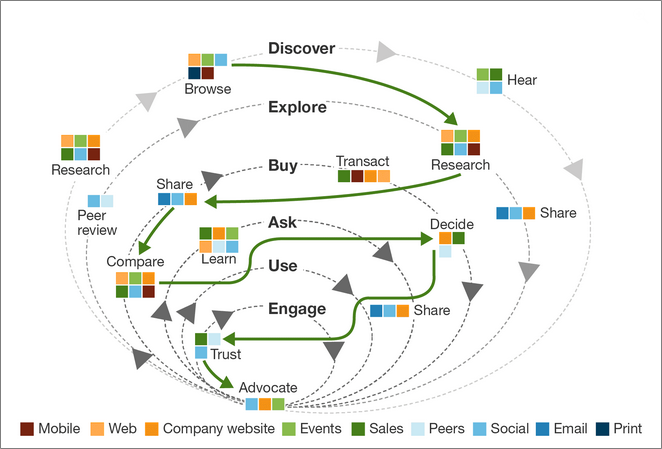Inbound Marketing for Manufacturers: Leveraging Sales Team Support
Many manufacturers with smaller marketing departments prioritize sales support: creating sales collateral, helping with trade shows, developing...
Inbound marketing—and the essential component of content marketing—may seem simple, but without a thorough understanding of the key tenets or a partner who can guide you, many companies unintentionally apply the strategy wrong and end up confusing and turning off their visitors.
It is not about “selling” visitors on what you do, it’s about creating, publishing, and distributing content for a targeted audience that provides helpful information to meet their needs.
Here are 5 common issues we frequently see that may be sabotaging your efforts and how you can make your content marketing better.
Everything starts with a plan, including marketing with content. You wouldn’t start building a house without a plan for what the house will look like when it’s finished, so why approach marketing, especially content marketing, any differently?
Start with the end in mind. What are your goals and what will success look like? Next, understand the profile of your target audience, what their buying process or journey looks like, and align the content you create to those stages. Plan the work, then work the plan. Your content marketing effort will be more successful.
This doesn’t need to be as daunting as it sounds – you can start with our fillable, one-page content marketing planner to get started right now!
Blogs are the front end, the driving force, of inbound marketing. They are the best vehicle to create content that gets discovered online by your target audience. And yes, people really do read blogs.
Consider this traffic graph from Twin Cities Habitat for Humanity of visitors to their site. Although they had been blogging since 2011, they really started publishing consistently in 2016. This is how their traffic increased. As you can see, blogging is an investment – a long-term investment in time and energy, but with a steady payoff into the future.

Blogging helps invite visitors to your website through the "side door". In a perfect world, you are writing content that is genuinely valuable to your prospective target audience – for example, let’s say you own a bike shop and want to attract customers who care about premium bike care in your area. As yourself, ‘What’s something they might search in Google?’ Immediately, you can get into their mindset and realize they might be searching:
Ideally, you will have written about any or all of these topics, and so they land on your blog page. They’re impressed with your thoughtful suggestions, and while on your website, they see that your business shares the same passion for bikes that they do. That’s how relationship-building begins.
Every time you publish a blog post it creates another indexed page on your website and increases the opportunities for you to appear in search engines. As discussed above, don’t use your blog as a place to put anything and everything—be strategic and use your blog with your marketing plan in mind and make sure it aligns.
Now that you have a plan, are publishing relevant content consistently, and are creating content that aligns with your target audience and their buying journey, you don’t want to stop there. You need to guide your audience to take another step with you to build trust with your brand.
A call-to-action (CTA) is a way to make it easy for your reader to learn more! In other words, creating a CTA for every piece of content shows your audience where to go next. Let’s go back to our bike shop example. After reading your blog post about “best bike trails in my area”, what do you want your reader to do next? Perhaps you’ve created a robust guide about “Bicycle Maintenance Tips from Wheel to Wheel” that showcases your expertise and would be a great piece of content for this person. A CTA would be an image and link to that piece of content. You’re telling them where you’d like them to click next.
Another great, simple CTA idea could be suggesting another blog post related to the topic they are interested in. Good content that answers their questions will keep them engaged and more likely to convert as they move through their buying process.
Read next: The 5 Fundamentals of Inbound Marketing
(See what we did up there? 😉👆👆)
Your content effort, if done properly, will produce more traffic to your website. It will be tempting to try and capture every person’s contact info as soon as possible. Be patient. And strategic. The digital world gives consumers the power to engage with you without having to identify themselves until they want to.
If you put a form on every piece of content or every CTA, you will likely turn more people away than you convert. Again, let’s go back to our bike shop example. Much of your content is available for free, such as your blog and a few simple videos. Then, you might want to add a simple form (name and email address) to a high-level offer, such as your bicycle maintenance guide. However, as visitors progress through their buyer’s journey, you want to start asking for more information about them. What city do they live in? What is their job title? Do they race professionally? By learning more about your prospect, you can offer more specific information tailored to their interests.
Use forms on CTAs that are further down the buying process and give some things away for “free” and your audience should stay engaged with you longer and eventually identify themselves.
It’s tempting for sure. After all, the reason you are leveraging marketing with content is to increase revenue and create new customers. Your audience wants to learn. They came to your blog looking for answers to their questions.
If all the content you create is a sales pitch, readers will see that immediately and leave to find their answers elsewhere, and likely won’t be back. You already have plenty on your website discussing your company and product or service. Keep your prospects engaged with your content by helping them and don’t force the sales process.

Many manufacturers with smaller marketing departments prioritize sales support: creating sales collateral, helping with trade shows, developing...

According to a recent study of Digital Marketing Agencies, over 60% of brands who utilize an outside marketing agency are looking for an all-in-one...
![[REVIEW] HubSpot Content Marketing Certification](https://www.clubmarketing.com/hubfs/2021-clean/images/blog/ContentMarketing-1.jpg)
As a content marketer working on the HubSpot platform, I'm thrilled with the newly-created Content Marketing Certification. Why? Because it puts...